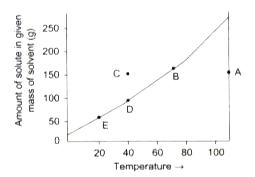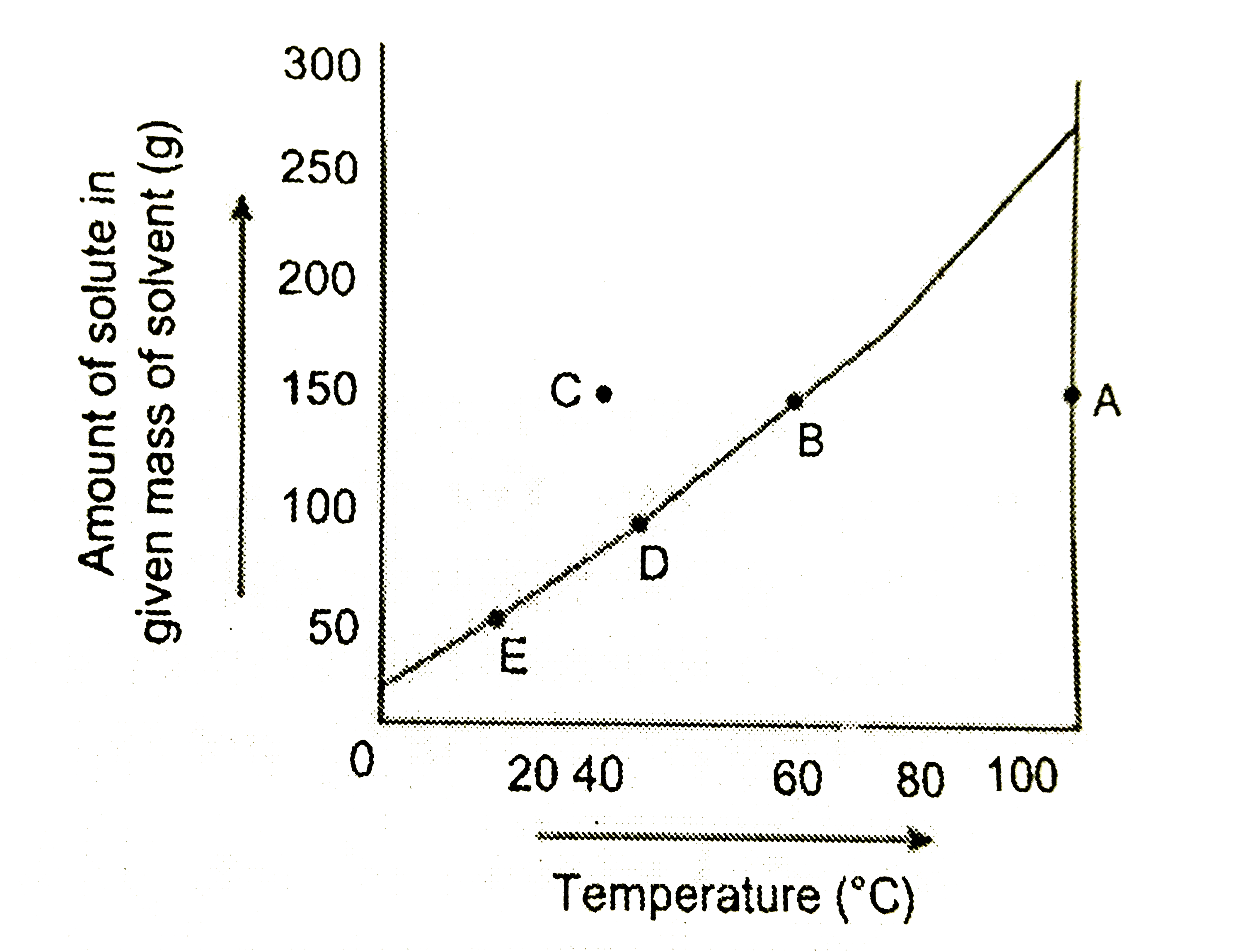
In the above graph, identify the states of solution at the various points A, B, C, D, E. If the solution is cooled from point A, at which temperature precipitation normally starts? Also find out the amount of solute precipitated at 40°C and the amount of solute in the solution at point E. What would be the maximum amount of solute that can be precipitated in the process?
The curve indicates that the solubility of the solute at 100°C is 250 g. However, the given solution contains only 150 g of solute. The solution at point A is an unsaturated solution. Therefore, no precipitation takes place up to point B at 80°C, where the solution becomes saturated with just 150 g of the solute. Point B indicates a saturated solution. Point C at 40°C indicates that the solution still contained 150 g of solute which is a supersaturated solution. That means, it is possible to cool solution from 80°C to 40°C without any crystallization by maintaining suitable conditions. At 40°C, when crystallization starts, the solution ultimately becomes saturated represented by point D. At point D (40°C), the solubility is 75. That means, 75 g of solute would have been precipitated out. At E also the solution remains saturated by precipitating 25 g more of solute.
Topper's Solved these Questions
- WATER, SOLUTION, SOLUBILITY AND HYDROGENBOOK - PEARSON IIT JEE FOUNDATIONCHAPTER - WATER, SOLUTION, SOLUBILITY AND HYDROGENEXERCISE - CONCEPT APPLICATION (LEVEL 2)
24 Videos
- SYNTHETIC FIBRES AND PLASTICS BOOK - PEARSON IIT JEE FOUNDATIONCHAPTER - SYNTHETIC FIBRES AND PLASTICS EXERCISE - COMPETITION CORNER (Choose the correct option)
53 Videos
Similar Questions
In the fraph given below, identify the states of solution at the various points A, B, C and E.If the solution is cooled from point 'A' at which temperature, precipitation normally starts ? Also, find out the amount of solute precipitated at 40∘C at A and the amount of solute in the solution at point 'E'. What would be the maximum amount of solute that can be precipitated in the process?

View SolutionWhat happens when freshly precipitated Fe(OH)3 is shaken with small amount of FeCl3 solution ?
View Solution
Knowledge Check
Assertion: If no more salt can be dissolved in the amount of water, the solution is said to be saturated solution.
Reason : On heating the saturated solution, the salt will precipitate out.AIf both assertion and reason are true and reason is the correct explanation of assertion.BIf both assertion and reason are true but reason is not the correct explanation of assertion.CIf assertion is true but reason is false.DIf assertion is false and reason is true.A solution which contains the maximum amount of the solute that can be dissolved in a given amount of solvent at a particular temperature is called -
ASaurated solutionBUnsaturated solutionCSuper Saturated solutionDNone of theseA beaker contains a solution of substance'A' precipitation of substance 'A' takes place when small amount of 'A' is added to the solution. The solution is………
AsaturatedBsupersaturatedCunsturatedDconcentrated
What happens when a freshly precipitated Fe(OH)3 is shaken with a little amount of dilute solution of FeCl3 ?
View SolutionWhat happens when a freshly precipitated Fe(OH)3 is shaken with little amount of dilute solution of FeCl3 ?
View SolutionA beaker contains a solution of substance'A' precipitation of substance 'A' takes place when small amount of 'A' is added to the solution. The solution is………
View SolutionSolution A is a strong acid
Solution B is a weak alkali
Solution C is a strong alkali
Which solution will give a gelatinous white precipitate with zinc sulphate solution ? The precipitate disappears when an excess of the solution is added.
View SolutionA beaker contains a solution of substance'A' precipitation of substance 'A' takes place when small amount of 'A' is added to the solution. The solution is………
View Solution
